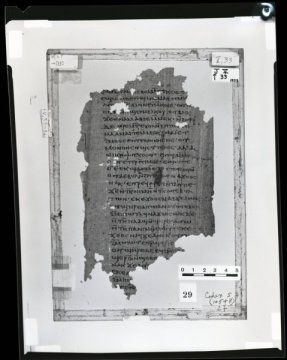Ancient copy of Jesus' secret papyrus teachings to his brother discovered
The first-known original Greek copy of the banned Christian manuscript was discovered in the Nag Hammadi Library at Oxford University.
Biblical scholars have discovered the first-known copy of a heretical text, which is thought to hold the secret teachings of Jesus to his brother James. Researchers at the University of Texas at Austin found the manuscript at Oxford University.
The writings are on a small piece of papyrus and are thought to be part of the Apocalypse of James, a book of the Bible that was banned by Emperor Constantine and was not part of the New Testament released in 367AD by Athanasius, Bishop of Alexandria.
The text was part of the The Nag Hammadi Library —a collection of 13 Coptic Gnostic books that were first discovered in Egypt more than 70 years ago in 1945. The codices were reportedly hidden in a jar in the Egyptian town of Nag Hammadi around 1,400 years ago and can be traced back to a time between the 2nd and 6th century CE.
Unlike the rest of the documents, the fragments recently discovered were not written in Coptic but in Greek.
"This new discovery is significant in part because it demonstrates that Christians were still reading and studying extra-canonical writings long after Christian leaders deemed them heretical," Geoffrey Smith, an assistant professor of religious studies at the University of Texas at Austin and one of the two scholars who made the discovery, told Newsweek.
"To say that we were excited once we realised what we'd found is an understatement," he added to Science Daily.
The ancient document reportedly describes secret teachings Jesus shared with his brother James, and includes information about the heavenly realm and future events, including James' inevitable death. "The text supplements the biblical account of Jesus' life and ministry by allowing us access to conversations that purportedly took place between Jesus and his brother, James -- secret teachings that allowed James to be a good teacher after Jesus' death," Smith said.

Brent Landau, a lecturer in the UT Austin Department of Religious Studies who worked on the find believes the text was used to teach students to read and write. "The scribe has divided most of the text into syllables by using mid-dots. Such divisions are very uncommon in ancient manuscripts, but they do show up frequently in manuscripts that were used in educational contexts," he explained.
Smith and Landau announced the discovery at the Society of Biblical Literature Annual Meeting in Boston in November and are working to publish their preliminary findings in the Greco Roman Memoirs series of the Oxyrhynchus Papyri.
For many, the suggestion that James was a blood relative of Jesus is a matter of debate. In 2002, archaeologists discovered a 2,000-year-old ossuary or "bone box" with Aramaic inscriptions that translated to: "James, son of Joseph, brother of Jesus".
If proved to be true, this would be the first-of-its-kind of evidence to indicate that Jesus has siblings. "The New Testament says nothing about Mary being a perpetual virgin, it says she virginally conceived Jesus, and it certainly implies that she went on to have more children after that, and his brothers and sisters are in fact his brothers and sisters," Ben Witherington, a professor of New Testament Interpretation at Asbury Theological Seminary, had earlier told CNN in 2015.






















